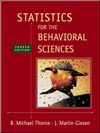 |  Statistics for the Behavioral Sciences, 4/e Michael Thorne,
Mississippi State University -- Mississippi State
Martin Giesen,
Mississippi State University -- Mississippi State
Measures of Dispersion and Standard Scores
Chapter Overview| Several statistics are introduced in this chapter to measure the spread or dispersion of the scores around the
mean in a distribution. The measures discussed are the range, the average deviation, the variance, and the
standard deviation.
The range (R) is the difference between the highest and lowest scores in a distribution. It is useful in a
descriptive sense because it is determined so easily. The major problem with the range is that it is based on
the two extreme scores in the distribution. If the extremes are not representative of the distribution, the
range will be unrepresentative as well.
The average deviation (AD) is the average of the deviations from the mean of the distribution of each
score in the distribution. It is computed by dividing the sum of the absolute value of the deviations by the
number of deviations. The absolute value of the deviations is used to prevent the sum of the deviations
from always being zero, because of the property of the mean as the balancing point in the distribution that
we discussed in Chapter 5. AD is introduced as a prelude to the variance and the standard deviation.
The variance is the average of the squared deviations. Population variance is symbolized by s2, and
sample variance is symbolized by s2. The numerator of the equation for the variance is sometimes called the
sum of squares or SS. The sample variance (s2) is an unbiased estimate of s2.
The standard deviation is the square root of the variance or the square root of the average squared
deviation. Symbols for the population standard deviation and the sample standard deviation are s and s,
respectively. The standard deviation can be visualized as another unit of measurement on the baseline of a
frequency polygon. A useful approximation of s can be found by dividing the range by 4.
A standard score or z score is the deviation of a raw score from the mean in standard deviation units.
The sign of the z score tells the direction of the score relative to the mean: Negative z scores represent raw
scores below the mean, and positive z scores indicate scores above the mean. |
|



 2003 McGraw-Hill Higher Education
2003 McGraw-Hill Higher Education